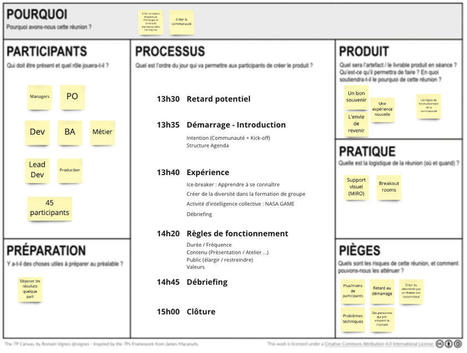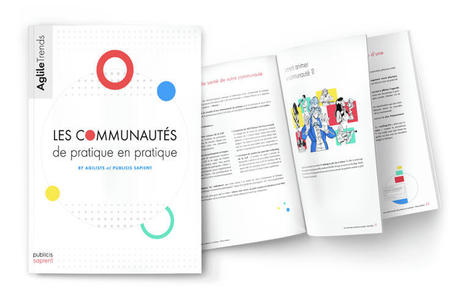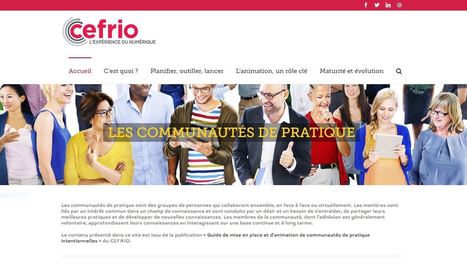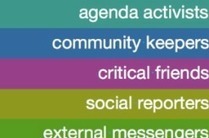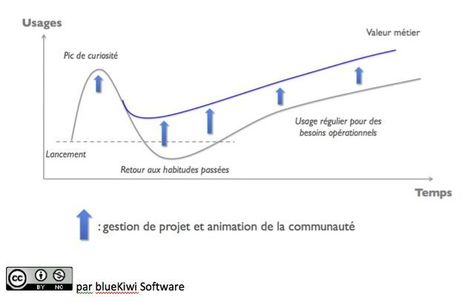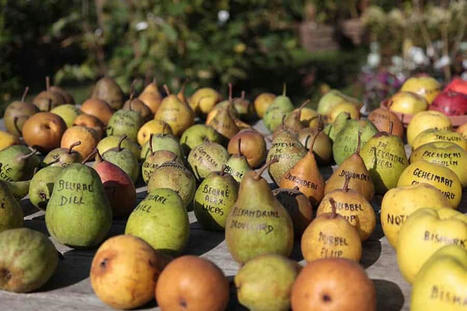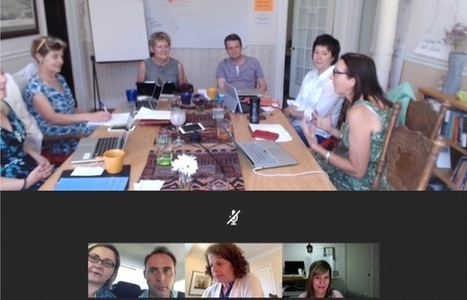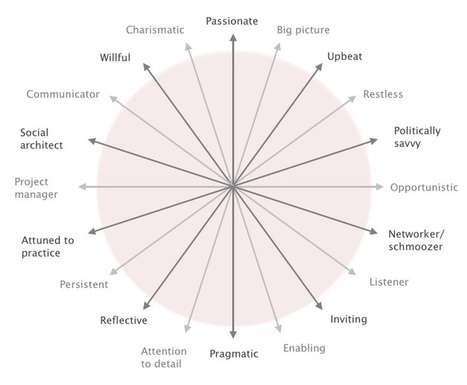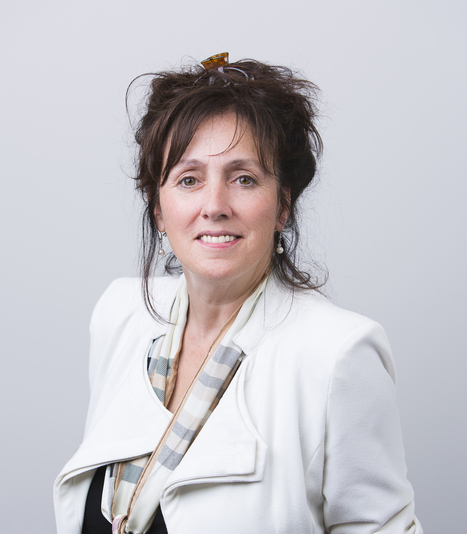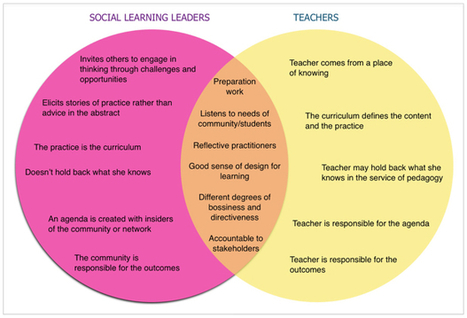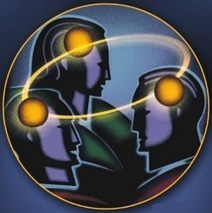 Your new post is loading...
 Your new post is loading...
Qu'est ce que l'"Analyse des Pratiques Professionnelles" ou "Analyse de la pratique professionnelle": Approches, Objectifs, Méthodologie, Règles
Lancement d'une communauté transverse de 40 personnes. Contexte, conception et animation de l'atelier à distance.
La seconde édition du Guide des Communautés de Pratique en Pratique, est disponible !
Le Lean Coffee est un format plutôt innovant d'animation de réunion, initié en 2009, du côté de Seattle. Il permet d'allier l'informel, la rapidité, la passion des discussions de café et l'efficacité des bonnes réunions de travail par un cadre et une facilitation favorisant une dynamique collective.
Les communautés de pratique sont des groupes de personnes qui collaborent ensemble, en face à face ou virtuellement. Les membres sont liés par un intérêt commun dans un champ de connaissance et sont conduits par un désir et un besoin de s’entraider, de partager leurs meilleures pratiques et de développer de nouvelles connaissances. Les membres de la communauté, dont l’adhésion est généralement volontaire, approfondissent leurs connaissances en interagissant sur une base continue et à long terme. Les communautés de pratique brisent les silos et facilitent la circulation et le développement de connaissances, surtout tacites, que ce soit au sein d’une organisation ou entre les organisations. Pourquoi des communautés de pratique? Les communautés de pratique dans les organisations du XXIème siècle - Pour survivre et progresser, les humains ont toujours eu à échanger leurs connaissances.
- Les individus apprennent ; les organisations aussi!
- Le modèle CTR-S de Ballay propose une boucle dynamique faisant intervenir, au moyen de processus sociaux : la capitalisation des connaissances, leur transfert, leur renouvellement.
- «On apprend toujours seul, mais jamais sans les autres!»
La communauté de pratique : une clé - Les communautés de pratique regroupent des gens qui veulent apprendre les uns des autres en partageant leur expérience
- Une communauté est très différente d’une équipe de travail.
- Une communauté se développe par phases successives.
- La démarche de mise en place proposée par le CEFRIO comporte certains rôles à pourvoir et différentes étapes à franchir.
Se décider - Les bénéfices potentiels des communautés de pratique incluent les gains de productivité, l’apprentissage et l’innovation.
- Une communauté ne pourra pas exister si ses membres n’y trouvent pas une valeur tangible pour eux-mêmes.
- Trois variables sont essentielles au succès : un environnement favorable, une thématique pertinente et un soutien adéquat.
- Les postes budgétaires à prévoir se répartissent en frais fixes et en frais annuels récurrents. Les montants peuvent atteindre les six chiffres.
- La qualité de l’animation et le temps qu’investissent les participants sont parmi les facteurs de succès les plus importants.
Le contenu présenté dans ce site est issu de la publication « Guide de mise en place et d’animation de communautés de pratique intentionnelles » du CEFRIO.
Having grown up in the French-speaking parts of Switzerland, Wenger achieved a B.S. in Computer Science from the University of Geneva, Switzerland, in 1982. He then studied at the University of California, Irvine, in the United States, gaining an M.S. in Information and Computer Science in 1984 and a Ph.D.
Source de créativité et d'innovation, l'économie du savoir développe de nouveaux rapports entre le milieu de la recherche universitaire et celui de la pratique professionnelle. Le projet Modes de travail et de collaboration à l'ère d'Internet visait essentiellement à étudier la mise en place, le fonctionnement et l'évolution d'un ensemble de communautés de pratiques virtuelles. Plusieurs des outils et analyses menées dans le cadre de ce projet ont été intégrés dans le microsite Les Communautés de pratique produit par le CEFRIO. Téléchargez les publications rattachées au projet
We find many people – across sectors – struggling to integrate learning in all phases of their project – from planning to implementation to evaluation.
Unfortunately, learning remains a side-show in many projects – a bit of training, knowledge-sharing, a piece of research, an evaluation report. But today embedding social learning has to be a strategic part of any innovative project. Our framework does just that. It acts as a shared language for negotiating aspirations, for framing the design, and for driving the learning through ongoing feedback loops and data collection.
This article was written by Etienne in 2009 for a textbook co-published by the Open University and Springer. It does two things. It relates the conceptual framework of communities of practice to systems theory and it reviews the career of the concept of community of practice since its inception in Etienne’s work with Jean Lave in 1987.
The practice goes like this: everyone at a meeting belongs to a leadership group – and each group stewards one part of the learning process of the whole group. In this way leadership of the community meeting is distributed over the entire event. Leadership here is seen as an act of service, that is, not leadership in terms of telling others what to do, but helping the group develop itself as a learning partnership. We’ve seen these groups lead to some transformational turn-arounds in group dynamics and the learning potential. (Notwithstanding the times they flopped – which led us to learn a great deal!)
A central concept in our social learning theory is that of a community of practice (Wenger, 1998). Our work with this concept is relevant to this article in two ways. First, the challenge of evaluating communities of practice has pushed us to develop an evaluation framework for social learning that integrates various data streams and makes sense to participants, evaluators, and stakeholders. It is this framework that we introduce in this article.1 Second, boundaries are salient features in our theory of learning. Communities of practice are formed through shared histories of learning. Over time these histories inevitably create boundaries between those who have been participating and others (Wenger, 1998). In our more recent work on learning in landscapes of practice, where learning capability involves multiple communities of practice, boundaries have become even more salient. While “boundaries are places of potential misunderstanding and confusion arising from different regimes of competence, commitments, values, repertoires, and perspectives,” they also “hold potential for unexpected learning” (Wenger-Trayner & Wenger-Trayner, 2014). Rather than trying to eliminate boundaries we propose treating boundary encounters as potential learning opportunities. Trying to foster learning beyond single practices has led us to engage with serious boundaries among communities whose members experience the world very differently—the chasms that Hesse-Bieber refers to. As such, our consultancy work dovetails with a view of mixed methods inquiry as a cross-boundary endeavor inviting “respectful conversation, dialogue, and learning one from the other, toward a collective generation of better understanding . . .” (Greene, 2007, p. xii).
The Knowledge Building (KB) theory was created and developed by Carl Bereiter and Marlene Scardamalia for describing what a community of learners needs to accomplish in order to create knowledge. The theory addresses the need to educate people for the knowledge age society, in which knowledge and innovation are pervasive.
Bâtir une ou des communauté(s) au sein d'un réseau social grand public ou d'entreprise (aussi appelé réseau social "privé") est certainement l'action la plus décisive et exaltante qui soit - car raison d'être du réseau lui-même - et la plus difficile.
|
C'est cadeau !🎁
Le PDF de mon intervention a Agile Tour Sophia 2023 👇
Sur le framework Community Canvas.
Un framework pour aider a bâtir des communautés… | 12 comments on LinkedIn
Bang the Table has found the surest way of how to grow online community through regular engagement by engaging often and eclectically on the widest possible range of subjects.
Ce numéro d’Innovations comporte deux cahiers spéciaux qui analysent la complexité de cette organisation innovante. Le premier met l’accent sur les communautés de connaissances, internes et externes à l’organisation, qui jouent le rôle « d’accélérateur d’innovation et de créativité » mais qui soulèvent nombre d’enjeux liés à la coordination, l’utilisation ou encore l’appropriabilité de la connaissance ainsi produite. Le second cahier présente l’innovation agile comme « activateur de lien », c’est-à-dire une capacité de l’organisation à interagir avec l’ensemble des parties prenantes liées à l’innovation.
Alors que le Crédit Agricole vient de publier un livre blanc consacré aux communautés de pratique au sein des grandes entreprises, Isabelle Collignon témoigne de l'exemple du groupe bancaire. Principaux intérêts, atouts et freins, précautions dans la mise en œuvre : la directrice du développement RH du Crédit Agricole livre son analyse pour Focus RH.
There is always a moment when face-to-face folk wave good-bye to those participating online. The feeling on both sides is one of friends parting. What is it that gets us to that moment? We’ve written before about our experience of blending online and face-to-face (here and here) but I thought I’d revisit the topic with our ongoing learning about what works for us – and what we could do better.
In our work we have observed many people taking up social learning leadership. One key observation is that they display seemingly contradictory characteristics. To engage BEtreaters in reflections on their leadership, we have put our observations on this diagram. Its axes represent what looks like paradoxes. We’ve noticed that good social learning leaders (or leadership teams) embody both ends of each axis. They manage to live with the tension; they embody the paradox. By rating themselves on each axis, participants were able to see the shape of their profile as social learning leaders, and even to think about who else should be on their team. For us this is a work in progress, so don’t be surprised if it looks different when we next see you. And whether it resonates or you have suggestions or a different experience, we’d be glad to hear from you.
Nos organisations évoluent de plus en plus dans une économie basée sur le savoir, source de créativité, d’innovation et d’amélioration de la compétitivité. Plusieurs stratégies, qu’elles soient mises de l’avant par des entreprises ou par des institutions, concourent à soutenir ce nouveau contexte d’affaires ; le développement de nouveaux rapports synergiques entre le milieu de la recherche universitaire et celui de la pratique professionnelle est l’une de celles-ci. Afin d'appuyer la mise en place et l'animation de communautés de pratique, le CEFRIO et ses chercheurs ont produit un guide pratique, dont l'information présente différentes sections riches en contenu afin d'aider les personnes à mettre en place « étape par étape » une ou des communautés de pratiques : - Présentation générale et définition de la communauté de pratique
- Comment planifier, outiller et lancer une communauté de pratique
- Comment animer une communauté de pratique
- Évaluation de la communuaté de pratique
On retrouve également une foule d'outils, tels que des grilles d'analyse et de planification budgétaire, des idées d'activités pour animer une communauté de pratique et l'évaluer ainsi que plusieurs références.
What are the similarities between a social learning leader and a teacher? We had a quick brainstorm and the results were captured by Bonnie Johnston
This brief and general introduction examines what communities of practice are and why researchers and practitioners in so many different contexts find them useful as an approach to knowing and learning.
La communauté de pratique peut se créer de façon spontanée. Toutefois dans une visée pédagogique, il convient de la mettre en place soigneusement en adoptant une démarche méthodique à même de garantir sa viabilité et sa pérennité
|
 Your new post is loading...
Your new post is loading...
 Your new post is loading...
Your new post is loading...






